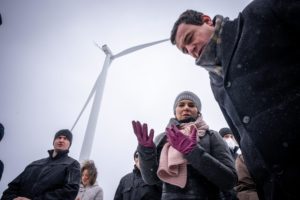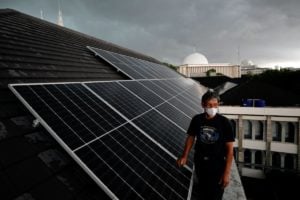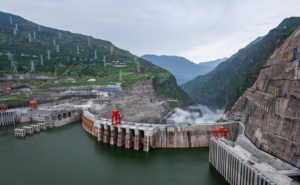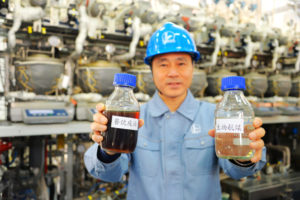Many observers have suggested the EU is increasing consumption of fossil fuels – particularly coal – as a reaction to the Ukraine war. However, data shows this is not true: consumption of gas and coal declined sharply in the second half of 2022, and coal use is set to fall further this year.
EU electricity demand dropped as a result of the Covid-19 pandemic, causing coal consumption and emissions to plummet in 2020, before rebounding from early 2021 until summer 2022. As economies recovered and electricity demand picked up, so too did coal consumption. This was caused by a widespread drought that affected hydropower production, and serious but temporary technical issues at French nuclear power plants.
However, coal consumption and CO2 emissions peaked below their pre-Covid level, and both have been falling since September 2022. As hydro and nuclear power normalise, and more solar and wind capacity comes online, coal consumption is set to fall even further this year.
The record-high fossil fuel prices caused by the sharp cuts in Russia’s supply to Europe have resulted in significant new clean energy policies and investments that will accelerate reductions in fossil fuel consumption in the coming years.
What caused the energy crisis?
The EU energy crisis started in summer 2021 and was caused by Russia’s decision to limit the gas supply to Europe in preparation for its invasion of Ukraine; supplies were cut further after the invasion started. This was a precarious period for the EU as energy demand was just starting to rebound from the drop caused by Covid-19. The reduction in supply from Russia over the winter of 2021–22 led to low levels of gas in storage.
EU emissions and coal use increased in the first half of 2022, which many observers blamed on the energy crisis. However, data shows it was the rebound in energy demand, which started in early 2021, that was responsible for the increase.
In early 2022, several additional factors contributed to the increase in coal and gas demand: widespread drought limited hydropower production; a historic heatwave in the summer raised electricity demand; and there was a drop-off in nuclear power generation. At the end of 2021, Germany shut three of its remaining six nuclear reactors in accordance with its nuclear phase-out plan. An even larger drop in nuclear power generation happened in France due to neglected maintenance of nuclear reactors and the discovery of stress fractures affecting most of the fleet.
None of these additional factors were structural and none were caused by the war or the energy crisis. It was simply a coincidence that they happened at the worst possible time for Europe’s energy supply security. The only consistent bright spot throughout the summer and autumn was solar power generation, which set new records every month, easing the pressure on gas- and coal-fired generation.
The figure below shows that in 2022 both hydropower and nuclear power generation fell far below their levels in the preceding five years. As a result, both coal- and gas-fired power generation increased year-on-year until August but started falling in September. In November, power generation from both coal and gas were at their lowest levels in at least 30 years.
In response to the gas supply cuts, the EU banned Russian imports of coal in August 2022 and crude oil in December. The almost complete stoppage of fossil fuel imports from Russia led the EU to increase imports from practically all other exporting countries. Policymakers focused particularly on securing gas and oil supplies. These imports covered the loss of supply from Russia but not the increased energy demand. Yet the scramble to secure fossil fuel imports contributed to the impression that EU demand was increasing.
Decisions to re-activate mothballed coal power plants and extend the lifetime of some plants, which were set to retire, added to the impression of a return to coal. The coal back-up measures affected 26 power plant units and ensured generation was available at critical times. It contributed little to coal consumption, as the plants were on average operated at a utilisation rate of only 18%.
Why are emissions falling now?
According to the laws of supply and demand, a dramatic reduction in the supply of fossil fuels, especially gas, will increase prices and reduce demand. This is what happened in the EU: as prices shot up, gas demand fell significantly below the previous year’s levels in May 2022, followed by electricity demand in August.
Without the supply cutbacks and high prices, emissions would very likely have increased more and for a longer time.
Analysis using temperature-corrected data shows that unseasonably warm weather connected to the warming climate is a contributing factor, but not the main cause of lower demand.
The EU’s CO2 emissions stopped increasing in July 2022 and have been falling since September. Besides the reduction in electricity and gas demand, the contributing factors are growth in wind and solar power generation, normalisation of hydropower availability, and progress in restoring nuclear power operation in France. Germany’s decision to extend the life of the country’s three remaining nuclear reactors, which were set to retire at the end of 2022, is helping to reduce coal- and gas-fired power generation in the first quarter of 2023.
The EU’s emissions stopped increasing in July 2022 and have been falling since September
Emissions likely increased in 2022 due to the large rebound early in the year. There is still a long way to go to restore the French nuclear fleet to full operation, which means that improved availability of nuclear power, together with increased solar and wind capacity, will help to reduce emissions throughout 2023.
Both coal- and gas-fired power generation are declining. Gas has been falling faster, due to the extremely high prices. Therefore, there has been a shift from gas to coal in power generation in relative terms, but it’s misleading to call this a return to coal since coal consumption is dropping too.
The market response
The security of supply implications of the fossil fuel crisis and the price implications of the broader energy crisis have resulted in forceful responses from energy markets and policymakers. Some of these responses can be seen in the spectacular growth of solar power, heat pump installations and electric vehicle sales.
According to SolarPower Europe, an industry trade body, nearly 32 gigawatts (GW) of solar PV capacity was installed across Europe in 2022, up a third compared with 2021. Solar is becoming an important energy source in Europe, generating a record 12% (99.4 terawatt hours) of EU electricity from May to August 2022, up 9% on the previous summer, according to Ember. Solar power generation is just 4 percentage points behind coal, which currently produces 16% of the EU’s electricity.
The boom in solar power generation is widely spread across the EU, with 18 of 27 countries breaking their former records in solar power generation as a share of total electricity generation last summer. This is the result of several years of solar investment, such as Poland’s 26-fold increase in solar power capacity since 2018, and the five-fold expansions in the same period in Hungary and Finland.
Europe’s installed solar power capacity was sufficient to substitute 210 terawatt hours of fossil gas from May through August, the equivalent of 44% of the imports from Russia over that period in 2021. These imports would otherwise have cost the bloc 29 billion euros, and increased its vulnerability to Russian gas cuts. However, while the boom in solar power is raising the resilience of the European energy system, wind power is still being held up in many countries by restrictions and slow permitting despite its economics being highly favourable.
Despite the increase in electricity prices, high and volatile prices for gasoline and diesel have made electric vehicles more competitive. In the second quarter of 2022, which is the first full quarter after the war began, the sales of passenger electric vehicles (EV) in Europe increased by 16% year-on-year. This comes on top of a 70% increase in 2021. In some markets, such as the Netherlands, Sweden and Norway, EVs are already the default purchase, with market share exceeding 50%. In Norway, their share hit 85% of all passenger cars bought in the second quarter of 2022.
Building owners are also scrambling to install heat pumps to reduce their energy consumption and reliance on gas in heating. High gas prices increased heat pump deliveries by over 50% in 2022 in Germany, compared with 2021, which in itself was a record year. Poland saw 120% growth and Finland 50% growth, while sales doubled in the first half of 2022 in Italy, Austria and the Netherlands.
The policy response
Supporting the market reaction is a host of EU and national policies promoting clean energy. The REPowerEU plan launched in May 2022 envisions that 45% of the EU’s energy mix in 2030 will consist of renewable energy, up from 40% in the earlier Fit for 55 plan. This includes all uses of energy, including heating, transportation, industry, as well as electricity. Reaching the target will require the EU to install 1,236 GW of wind and solar by 2030, which is 16% higher than the 1,067 GW envisaged in the Fit for 55 strategy.
A report by Ember and CREA shows that the EU’s heightened ambition is supported by accelerated decarbonisation plans in most EU member states. By June 2022, 19 governments had already announced plans to accelerate the green shift in response to the Covid-19 pandemic and Russia’s threat to their energy supply and security. In the power sector, these plans are set to deliver an 82% share of non-fossil energy sources in EU power generation by 2030, which is a substantial increase from the share of 74% projected following plans in place at the end of 2019. This means an almost complete phase-out of coal and a substantial reduction in the use of fossil gas in the power sector – the share of fossil fuels in EU power generation was 36% in 2021.
Resolving issues that are suppressing wind power expansion in Europe will be key to realising these goals, and EU governments have announced plans to do so. One example is the Onshore Wind Energy Act, launched by the German government to overcome hurdles slowing the expansion of German wind power capacity. The act will allow wind power installation on 2% of Germany’s land area. It seeks to install 10 GW of onshore wind power capacity annually, almost five times more than the average installation over the years 2018–2021. Another example includes the agreement between eight EU countries bordering the Baltic Sea to reduce their dependence on Russian energy. Together, they will increase offshore wind power capacity seven-fold by 2030. Such measures will increase European energy security and diminish the reliance on CO2-emitting fuels and their insecure value chains.
Simultaneously, the EU and its member states are boosting their targets for energy efficiency and energy savings to directly cut the need for Russian gas. On the EU level, this includes heightening the bloc’s energy consumption reduction target from 9% to 13%, meaning that the EU will cut its energy use by an additional 4 percentage points by 2030 compared to the reference scenario. This target is complemented by several measures, including increasing the energy efficiency of buildings and installing 10 million new heat pumps in European households within the next five years. The German government has already embraced this approach, and has called upon the heat pump industry to ramp up production capacity to aid Germany to install 500,000 new units yearly from 2024.
EU emissions are not yet falling fast enough to align with climate targets, but policies and market trends are moving in that direction. The key challenges are permitting processes, which in many EU countries are slow and cumbersome, particularly for wind turbines and transmission lines; and input cost increases for equipment manufacturers that have led many to struggle despite strong market demand. EU policymakers are also concerned about the high degree of import reliance for some key raw materials and technologies that are central for the energy transition, such as rare earth metals, polysilicon and batteries. Policy proposals to address these issues are emerging.
High energy prices and supply concerns have led to reductions in EU coal consumption and CO2 emissions. The rebound in coal and other fossil fuel use that was associated with the economic recovery after Covid-19 has ended, and coal use and CO2 emissions never rose above the pre-pandemic levels. The fossil fuel supply shock has also accelerated clean energy investments and the energy transition, leading to a faster coal phase-down and emissions reductions in the coming years than previously expected.










